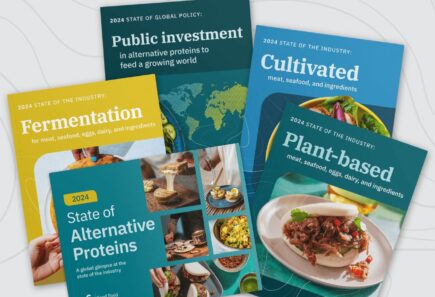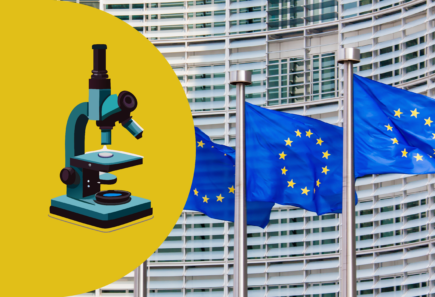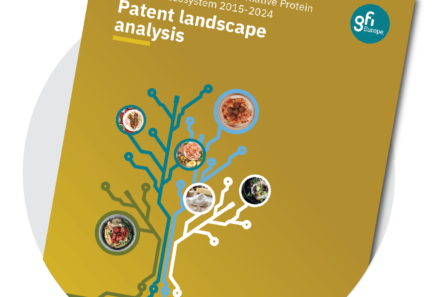Cultivated meat
Your guide to the science, business and policy of cultivated meat in Europe.

What is cultivated meat?
Cultivated meat aims to deliver chicken, pork, beef and seafood that is indistinguishable from the meat we eat today. It’s made from animal meat and fat cells which are cultivated in fermentors (like those used for brewing beer) and mixed with plant ingredients to produce familiar meat products.
Why do we need cultivated meat?
Compared with conventional meat production, cultivated meat has the potential to be far less resource-intensive, decreasing methane emissions, deforestation, biodiversity loss, water use, water pollution, antibiotic resistance, and foodborne illnesses.
A peer-reviewed study by CE Delft – the first ever to be based on data from cultivated meat companies – found that, compared with farming animals, cultivating meat from cells could:
- Cut the climate impact of meat by up to 92%.
- Reduce air pollution by up to 94%.
- Use up to 90% less land.
This is compared to an ambitious scenario for conventional animal agriculture in 2030 – where farmers manage to cut the carbon footprint of meat by 15% (for beef), 26% (for pork) and 53% (for chicken). Compared with current average environmental impacts, the benefits of cultivated meat are even greater. And if we use the freed-up land for rewilding or carbon sequestration, the positive climate impacts could be greater still.
Cultivated meat is also made in clean environments without animals or exposure to faecal pathogens, and no antibiotics are needed – so these foods help to reduce the risk of zoonotic diseases, prevent foodborne illnesses, and preserve life-saving antibiotics for human medicine.
Cultivated meat will expand the options available to consumers, providing the meat so many people desire, just produced in a more sustainable, secure and just way.
How is cultivated meat made?
Cultivating meat is similar to growing plants from cuttings in a greenhouse, which provides warmth, fertile soil, water and nutrients.
It involves taking a small sample of cells from an animal and growing them in a fermentor, similar to those used for brewing beer. This supports the same process that happens inside an animal by providing the warmth and the basic nutrients needed to produce meat – water, proteins, carbohydrates, fats, vitamins and minerals – in a sustainable way.
The result is animal fat or ground meat, which can be mixed with plant-based ingredients to make final products that are indistinguishable from conventionally produced meat.
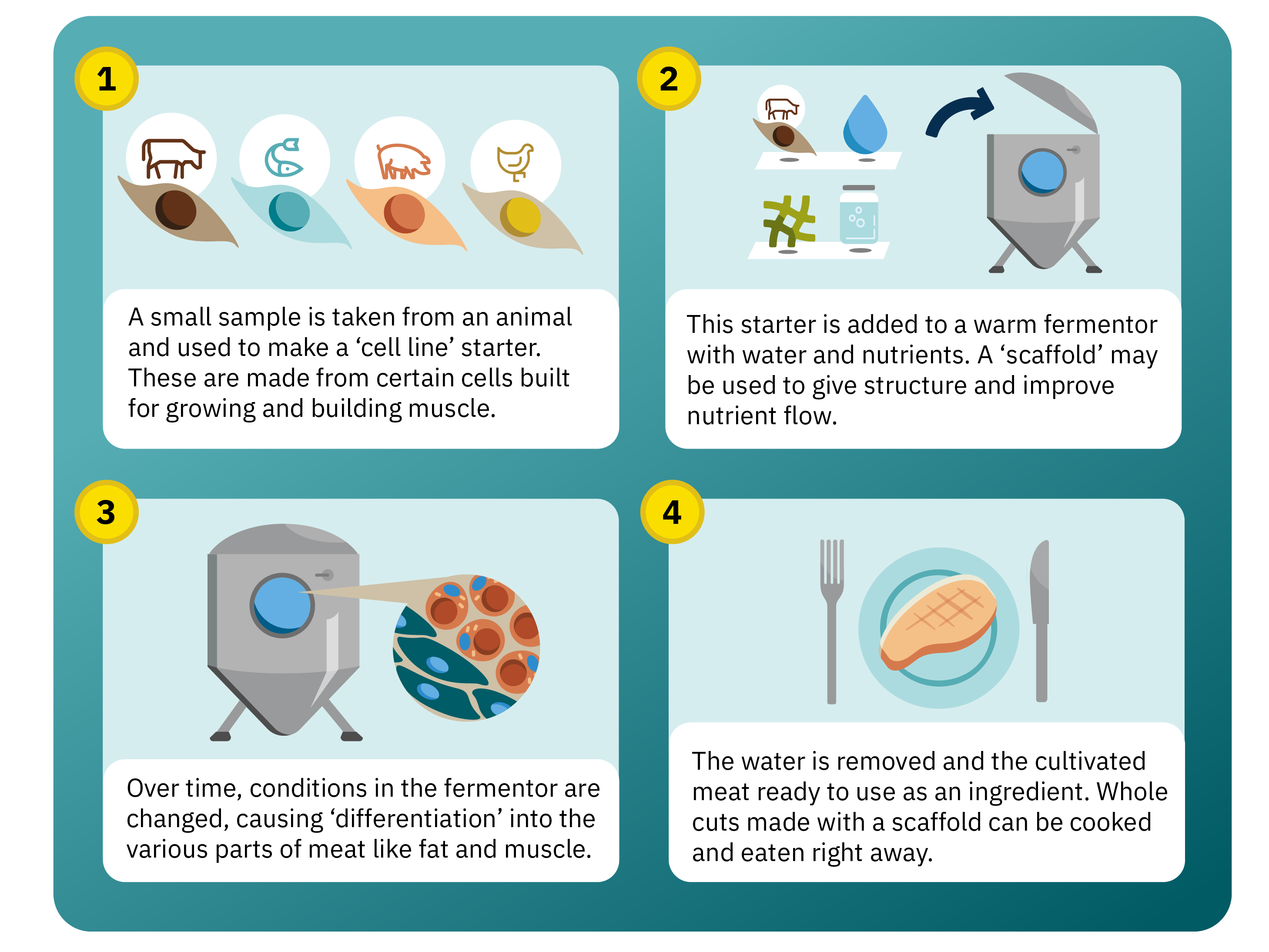
When will cultivated meat be available in Europe?
The first cultivated products to become widely available in Europe are likely to be ingredients like cultivated fat, which can enhance the flavour of plant-based meat, or products containing small quantities of cultivated meat cells.
Since mid-2023, several companies have submitted applications to sell cultivated meat and ingredients in the EU, Switzerland and the UK. Regulators are now undertaking thorough and evidence-based assessments of the safety and nutritional value of these products, and the approval processes are expected to take at least 18 months from submission, though in practice they can take several years.
Cultivated meat products have already been approved for sale in Singapore and the United States, so the fact that it has passed rigorous approval processes in those countries suggests it can play a role in a safe and sustainable future for Europe’s food system. However, cultivated meat remains at an early stage in its development, and still requires significant investment from governments into research and infrastructure to support product development and scale-up before products with cultivated ingredients become widely available, and before 100% cultivated meat products become a reality.
GFI Europe is working with the EU and national governments to ensure that the regulatory approval process for cultivated meat is robust, clear, and evidence-based.
How can we advance cultivated meat in Europe?
The world’s first cultivated beef burger was unveiled in London in 2013. Since then, startups across Europe have made incredible progress in developing cultivated meat and ingredients – but it will take government investment to achieve their full potential and maximise the societal benefits of cultivated meat.
Public sector investment in open-access research can address foundational issues and support the growth of a whole sector, rather than just one company. Just like they fund research and development into green energy, governments interested in enhancing food security, supporting economic growth and achieving their climate targets should fund open-access research into plant-based foods, cultivated meat and fermentation.
With the right support and investment, research suggests the cultivated meat sector could add up to €85 billion annually to the EU economy by 2050, and create up to 90,000 jobs. To achieve this, both the public and private sectors will need to invest significant sums into research and development to overcome existing challenges
Why is it called cultivated meat?
Many terms have been used to describe meat grown from cells – from “slaughter-free meat” to “cultured meat” and “lab-grown meat”. “Lab-grown meat” is an especially misleading term. At scale, cultivated meat is produced in cultivators, in a facility similar to a brewery. All sorts of food, from beer to bread, begins in a food lab – but we don’t call cornflakes “lab-created cornflakes”.
Cultivating meat can be thought of in the same way as cultivating plants in a greenhouse, where plant cuttings are given warmth, fertile soil, water and nutrients to help them to grow. A cultivator is what cultivated meat grows in. This is a reactor which facilitates the same biological process that happens inside an animal by providing warmth and the basic elements needed to build muscle: water, proteins, carbohydrates, fats, vitamins and minerals.
To achieve the incredible potential of cultivated meat to help tackle the climate crisis, restore nature, protect public health and improve food security, consumers must understand and embrace it. In 2019, GFI began using the term “cultivated” following an extensive research project to develop a narrative and decide on a term that was neutral, understandable and appealing to consumers.
Research into the best terminology across key European languages published by GFI Europe in 2022 also found that ‘cultivated meat’ is also the most appropriate terminology to when writing in and translating into German, French, Italian and Spanish. For the project, media analyses, representative surveys and focus group discussions were carried out in each of the respective countries.

The science of cultivated meat
Learn more about the science and technology behind cultivated meat – and the white spaces where more research is needed to accelerate the transition to a sustainable, secure and just food system.
The business of cultivated meat
Europe’s cultivated meat sector is developing rapidly, with companies producing everything from beef burgers to foie gras. Since mid-2023, several companies have submitted applications to sell cultivated meat and ingredients in the EU, Switzerland and the UK.
But cultivated meat remains at an early stage in its development, and still requires significant investment from governments into research and infrastructure to support product development and scale-up before products with cultivated ingredients become widely available, and before 100% cultivated meat products become a reality.
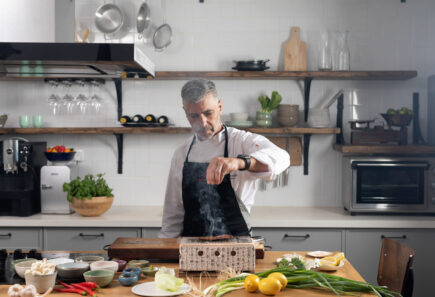
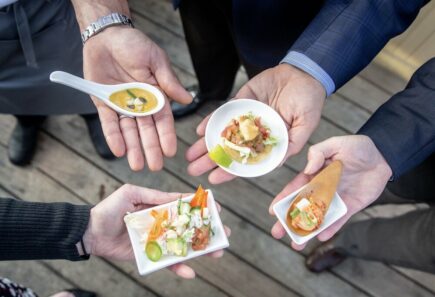
The policy of cultivated meat
Cultivated meat needs government support and approval before it can deliver on its potential to help tackle the climate and ecological emergency, protect public health and enhance food security.
GFI Europe advocates public investment in cultivated meat R&D, evidence-based regulation, and transparent labelling rules to help consumers make more sustainable choices.




